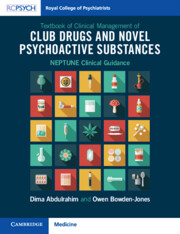 Textbook of Clinical Management of Club Drugs and Novel Psychoactive Substances
Textbook of Clinical Management of Club Drugs and Novel Psychoactive Substances Book contents
- Textbook of Clinical Management of Club Drugs and Novel Psychoactive Substances
- Textbook of Clinical Management of Club Drugs and Novel Psychoactive Substances
- Copyright page
- Contents
- Acknowledgements
- Part I Introduction and Background
- Part II Drugs with Primarily Depressant Effects
- Chapter 3 Gamma-Hydroxybutyrate (GHB) and Gamma-Butyrolactone (GBL)
- Chapter 4 New Benzodiazepine Novel Psychoactive Substances
- Chapter 5 Synthetic Opioid Novel Psychoactive Substances (Fentanyl and Non-fentanyl)
- Chapter 6 Ketamine and Other Novel Psychoactive Substances with Dissociative Effects
- Chapter 7 Nitrous Oxide (N2O)
- Part III Drugs with Primarily Stimulant Effects
- Part IV Drugs with Primarily Hallucinogenic Effects
- Part V Synthetic Cannabinoid Receptor Agonists
- Part VI Concluding Remarks
- Index
- References
Chapter 7 - Nitrous Oxide (N2O)
from Part II - Drugs with Primarily Depressant Effects
Published online by Cambridge University Press: 06 October 2022
- Textbook of Clinical Management of Club Drugs and Novel Psychoactive Substances
- Textbook of Clinical Management of Club Drugs and Novel Psychoactive Substances
- Copyright page
- Contents
- Acknowledgements
- Part I Introduction and Background
- Part II Drugs with Primarily Depressant Effects
- Chapter 3 Gamma-Hydroxybutyrate (GHB) and Gamma-Butyrolactone (GBL)
- Chapter 4 New Benzodiazepine Novel Psychoactive Substances
- Chapter 5 Synthetic Opioid Novel Psychoactive Substances (Fentanyl and Non-fentanyl)
- Chapter 6 Ketamine and Other Novel Psychoactive Substances with Dissociative Effects
- Chapter 7 Nitrous Oxide (N2O)
- Part III Drugs with Primarily Stimulant Effects
- Part IV Drugs with Primarily Hallucinogenic Effects
- Part V Synthetic Cannabinoid Receptor Agonists
- Part VI Concluding Remarks
- Index
- References
Summary
The evidence on the management of the acute and chronic harms associated with the recreational use of nitrous oxide (N2O) is limited and consists mainly of case reports, with occasional experimental studies into acute effects. There are few findings on acute harms and interventions relating to the use of the drug, but consistent findings on the chronic effects of prolonged nitrous oxide use.
- Type
- Chapter
- Information
- Textbook of Clinical Management of Club Drugs and Novel Psychoactive SubstancesNEPTUNE Clinical Guidance, pp. 131 - 142Publisher: Cambridge University PressPrint publication year: 2022
